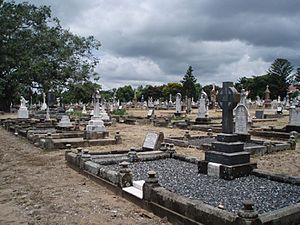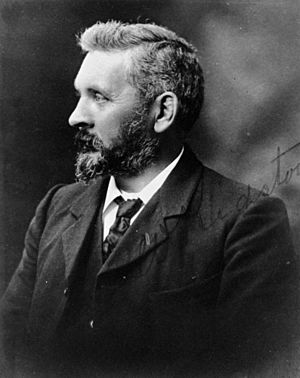South Rockhampton Cemetery facts for kids
Quick facts for kids South Rockhampton Cemetery |
|
|---|---|

South Rockhampton Cemetery, 2009
|
|
| Location | Upper Dawson Road, Allenstown, Rockhampton Region, Queensland, Australia |
| Design period | 1840s - 1860s (mid-19th century) |
| Built | 1860 - 1970 |
| Official name: South Rockhampton Cemetery, Dawson Road Cemetery, Rockhampton Cemetery | |
| Type | state heritage (landscape, built) |
| Designated | 15 February 1993 |
| Reference no. | 601131 |
| Significant period | 1860- (historical, fabric, social) |
| Significant components | denominational divisions, plaque, watercourse - creek, grave marker, headstone, pathway/walkway, cemetery, burial/grave, sculpture, trees/plantings, grave surrounds/railings |
| Lua error in Module:Location_map at line 420: attempt to index field 'wikibase' (a nil value). | |
The South Rockhampton Cemetery is a special place in Allenstown, Rockhampton Region, Queensland, Australia. It is a heritage-listed cemetery, meaning it is protected because of its history and importance. People were buried here from 1860 until about 1970. It is also known as Dawson Road Cemetery or simply Rockhampton Cemetery. This cemetery was added to the Queensland Heritage Register on 15 February 1993.
Contents
A Look Back: The Cemetery's History
The South Rockhampton Cemetery was first planned in May 1860. It was meant to be the town's main public cemetery. Before this, people were buried near the Fitzroy River. Rockhampton was a new town then, with fewer than 1,000 people. The first settlers had only arrived five years earlier in 1855.
Rockhampton's Growth and the Cemetery
Rockhampton grew very quickly in the 1860s. Many new people came to the area. Immigrant ships brought workers, and gold discoveries nearby attracted more people. This included Europeans, Chinese, and people from other parts of Australia. The cemetery's history shows how fast the town became a major centre.
The first burials happened in the early 1860s. The oldest headstone still standing is from 1861. At first, the Rockhampton Municipal Council looked after burials. But it wasn't until 1864 that they started managing the cemetery properly.
Managing the Cemetery and New Features
In 1864 and 1865, the Council hired a caretaker called a "sexton." They also made rules for the cemetery and started keeping a record of all burials. The grounds were set up with different areas for major religious groups. They even moved some remains from the older burial ground to this new one.
Later, in 1886, a group of trustees was put in charge. In 1867-68, a French plant expert named Anthelme Thozet gave trees and seeds to the cemetery. These came from his famous experimental gardens in Kalka.
Expanding the Cemetery Grounds
Even though people were using the cemetery for over ten years, its land wasn't officially set aside until 1872. At that time, about 3 hectares (about 7.4 acres) were made a special reserve for cemetery use. In 1880, the area was made much larger, growing to nearly 13 hectares (about 32 acres).
This larger area included all the land between Dawson and Upper Dawson Roads, and Prospect and Ferguson Streets. Before 1904, people didn't bury bodies in the western part because it was too rocky. For the same reason, few graves were dug east of the creek that runs through the cemetery. This led to problems with too many graves in a small area. This problem became even worse in 1900 when a serious illness, the bubonic plague, spread through the town.
Changes and Closure
Later, the Rockhampton Cemetery Trust bought more land in Norman Gardens. In 1930, the South Rockhampton cemetery was officially closed for new burials. However, people could still be buried in plots they had bought before May 15, 1930.
In 1937, about 1.6 hectares (about 4 acres) of the cemetery land was turned into a public park. No graves were found in this part. In 1964, the Rockhampton City Council became the trustee of the cemetery. Burials stopped completely around 1970. Today, the land is still owned by the government. Some old features like the caretaker's cottage and a Chinese incense burner are no longer there. The old iron entry gates were moved to the Japanese gardens.
Famous People Buried Here
More than 22,000 people were buried in this cemetery between 1860 and 1970. This includes people from many different backgrounds, such as Aboriginal, Chinese, German, and Jewish communities. You can find memorials for sailors, miners, soldiers, religious leaders, mayors, and many of Rockhampton's first residents. The cemetery helps us understand the city's social and political history.
Some well-known people buried here include:
- John Cani, a Roman Catholic Bishop of Rockhampton.
- Will Crompton, a poet.
- Owen Daniel, a member of Queensland's parliament.
- Sydney Davis, a member of Queensland's parliament.
- Thomas Dunlop, a member of Queensland's parliament.
- James Flint, an architect and a local council member.
- William Harding, a member of Queensland's parliament.
- William Higson, a member of Queensland's parliament.
- William Kidston, a member of Queensland's parliament and the Premier of Queensland (the leader of the state government) from 1908 to 1911.
- William Frederick Lambert, a member of Queensland's parliament.
- James Larcombe, a member of Queensland's parliament.
- John MacFarlane, a member of Queensland's parliament.
- Charles Melbourne, a member of Queensland's parliament.
- Frank Reid Murphy, a member of Queensland's parliament.
- Francis Hodgson Nixon, an architect and newspaper owner.
- Edward Palmer, a member of Queensland's parliament.
- William Pattison, a member of Queensland's parliament and the Treasurer of Queensland (in charge of the state's money).
- Frederick Shaw, a member of Queensland's parliament.
- Joseph Shiel, a Roman Catholic Bishop of Rockhampton.
The cemetery also has two Commonwealth war graves. These are for soldiers from the Australian Army who died in the two World Wars.
What the Cemetery Looks Like
The South Rockhampton Cemetery is on a slope of The Range. It covers the area bordered by Prospect Street, Upper Dawson Road, and Ferguson Street. Next to it, along the Bruce Highway, there's a park, a tourist information centre, and a service station.
Cemetery Layout and Headstones
The cemetery is divided into different sections for various religious groups. These include areas for the Church of England, Roman Catholic, Presbyterian, Methodist, Baptist, Congregational, and Jewish faiths. There are also sections for non-Christian groups. A main path runs north to south, and smaller paths go east to west.
You can still see about 2,000 headstones today. Many other graves exist as mounds of earth, but their headstones are gone. The graves create a terraced look across the site. However, in the non-Christian sections, like those for Chinese and Aboriginal groups, there are often no visible memorials, as their burial traditions were different.
Natural Features and Stone Types
A small creek flows from the southwest corner through the Church of England section to the eastern edge. Some headstones are found in the overgrown areas near this creek, including the only remaining cast iron headstone. A sandstone rock formation is visible in the creek. One headstone from 1862 is believed to have been made from this local sandstone. It looks different from the Stanwell sandstone used for most other headstones.
Other local stones used include white Ulam marble and black granite from areas near Rockhampton. Imported stones came from places like Victoria, Brisbane, Italy, and Finland.
Most of the stone carving was done by local companies. You can sometimes see the names of the individual stonemasons on their work. Some sculptures were imported already finished.
Headstone Styles and Designs
The headstones show different architectural styles from over the years. You can see influences from Gothic, Classical, and Art Nouveau designs. Often, the grave surrounds (the borders around the grave) were part of the headstone's overall design, making it a complete sculpture.
Over time, the way grave surrounds were made became simpler. In the years between the two World Wars, cast concrete posts and curbs became common. Detailed carving was then mostly kept to the headstone or plaque itself.
Trees and Plants
The cemetery has some interesting trees. You can find Banyan trees (Ficus benghalensis) at the north entrance and in the centre. Hoop Pines (Araucaria cunninghamii) and Weeping Figs (Ficus benjamina) grow along the north boundary. Cook Island Pines (Araucaria cookii) and palms (Livistona drudei) are in the southeast. There's also a native almond tree (Terminala porphyrocarpa) named after A. Thozet, the botanist who donated plants. The park next to the cemetery has barbecue areas and playgrounds.
Sadly, some headstones have been damaged over time.
Why This Cemetery is Important
The South Rockhampton Cemetery was added to the Queensland Heritage Register on 15 February 1993. This means it is recognized as a very important historical site.
Showing Queensland's History
The cemetery, started in 1860, helps us understand how Queensland's history developed. It shows us the different cultures, religions, and groups of people who lived in the Rockhampton area. It also shows how monumental designs (like headstones) changed over more than a century.
Its Beautiful Design
The many different memorials, the way the grounds are laid out, and the special collection of old plants make the cemetery beautiful. People who are interested in the skill of stonemasons and the history of cemetery design value its unique look.
Connection to Important People
The cemetery is important because it is linked to people who played a big part in Queensland's history and in the Rockhampton area. This includes William Kidston, who was the Premier of Queensland from 1908 to 1911, and several mayors of Rockhampton.


